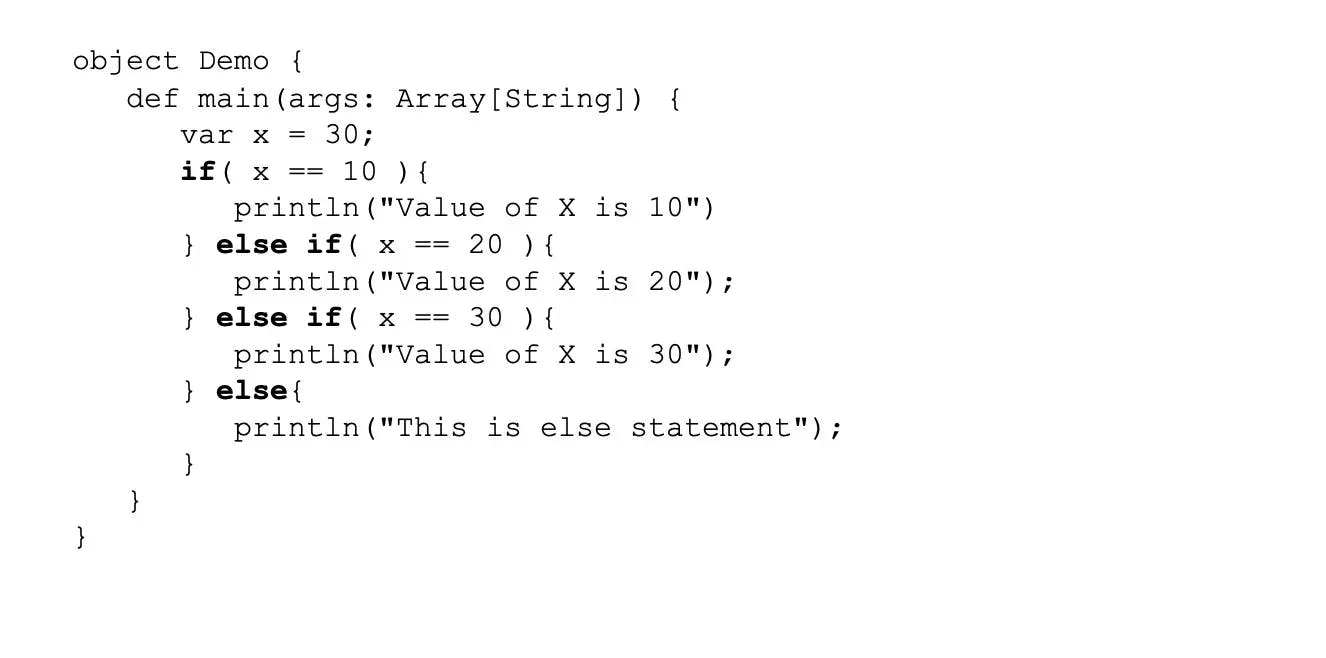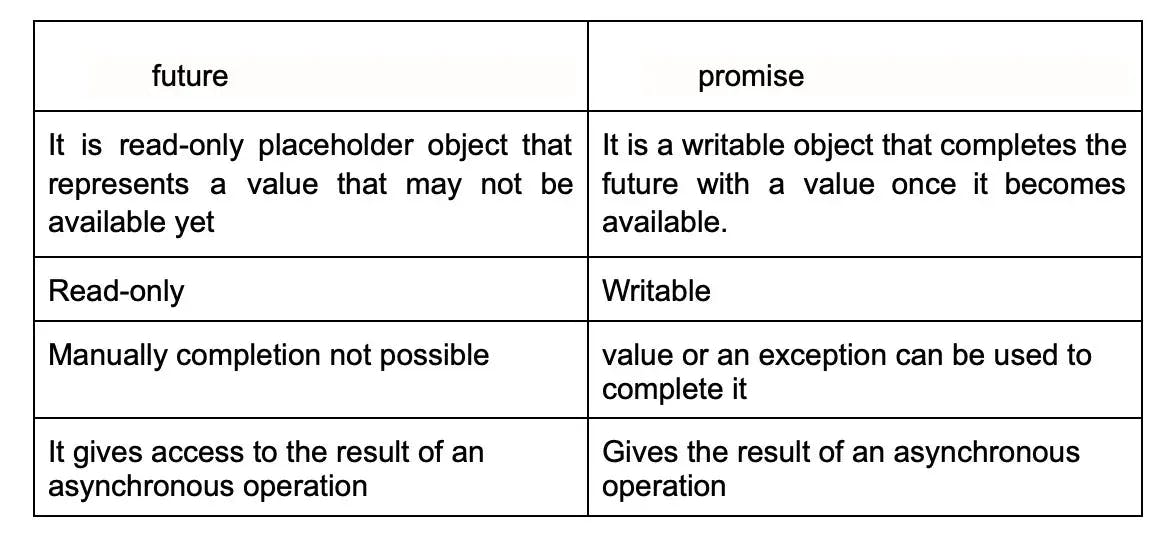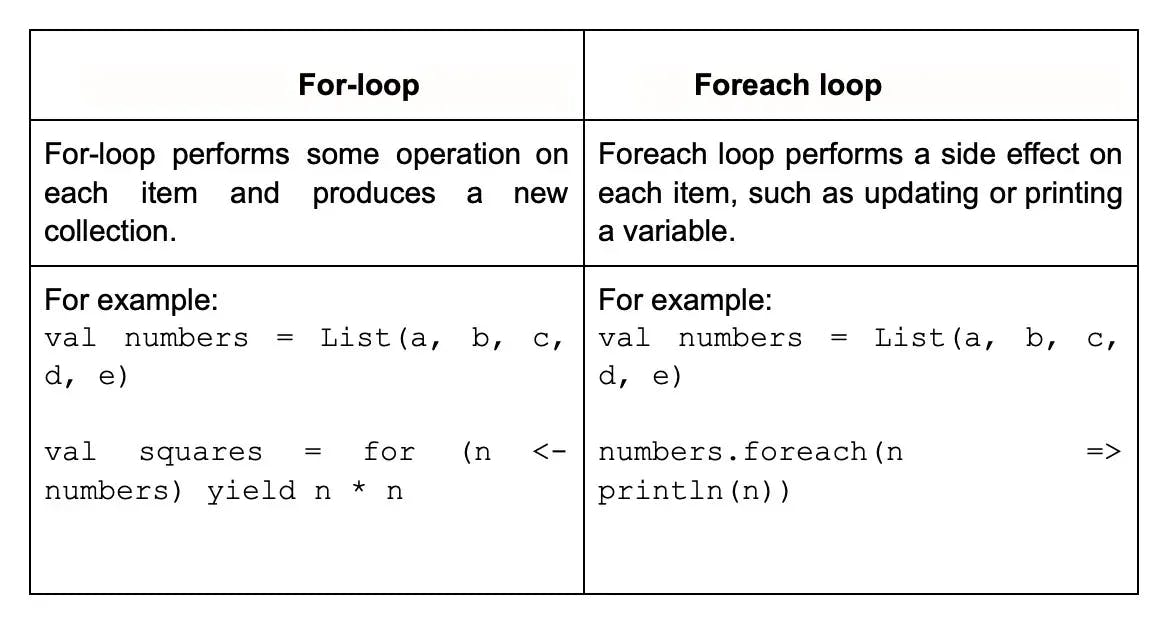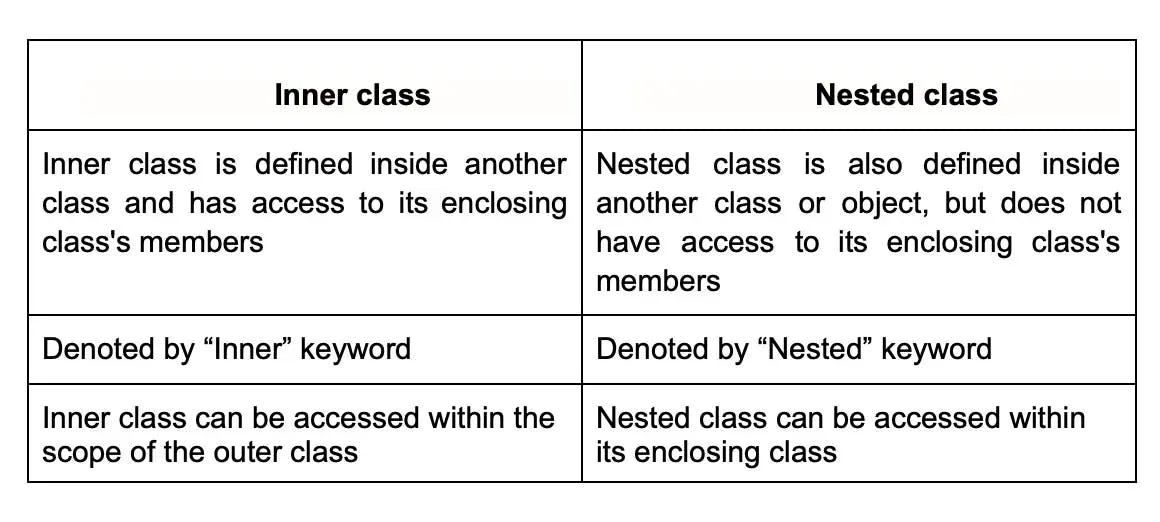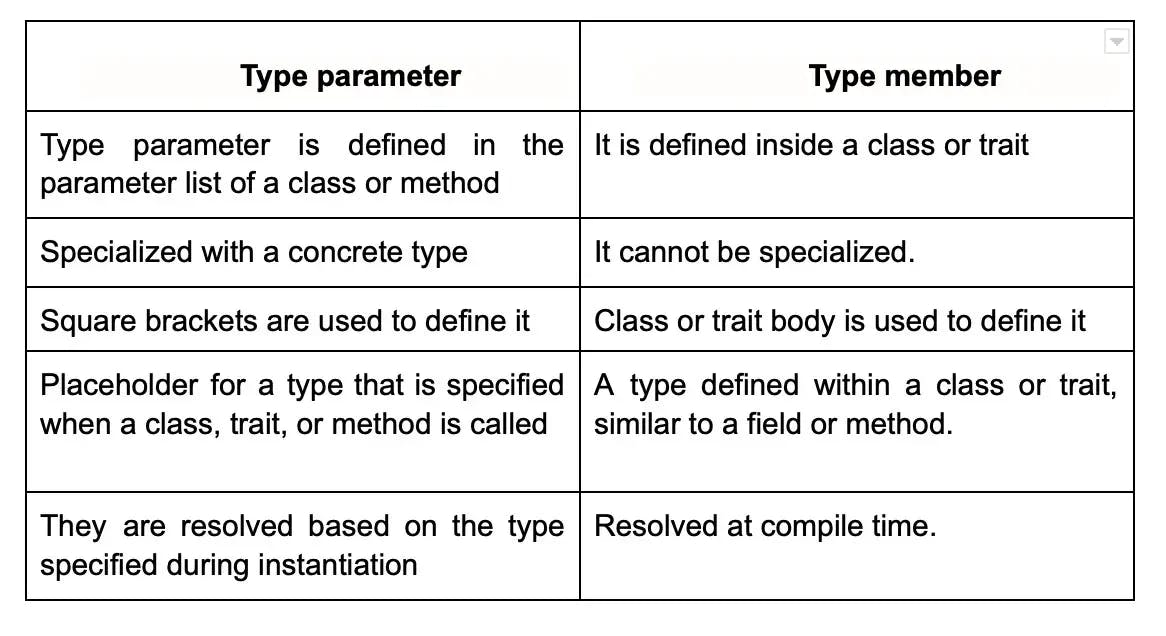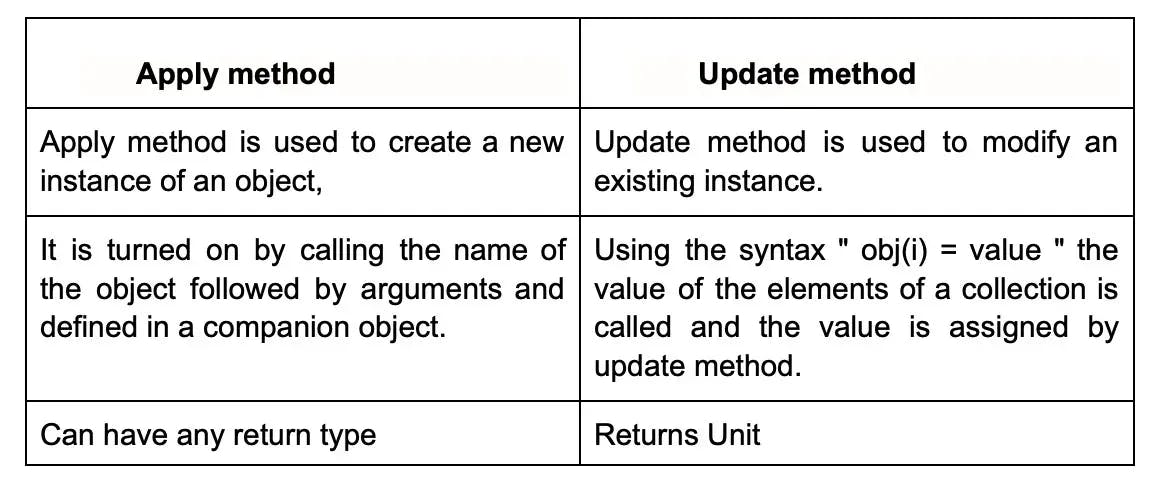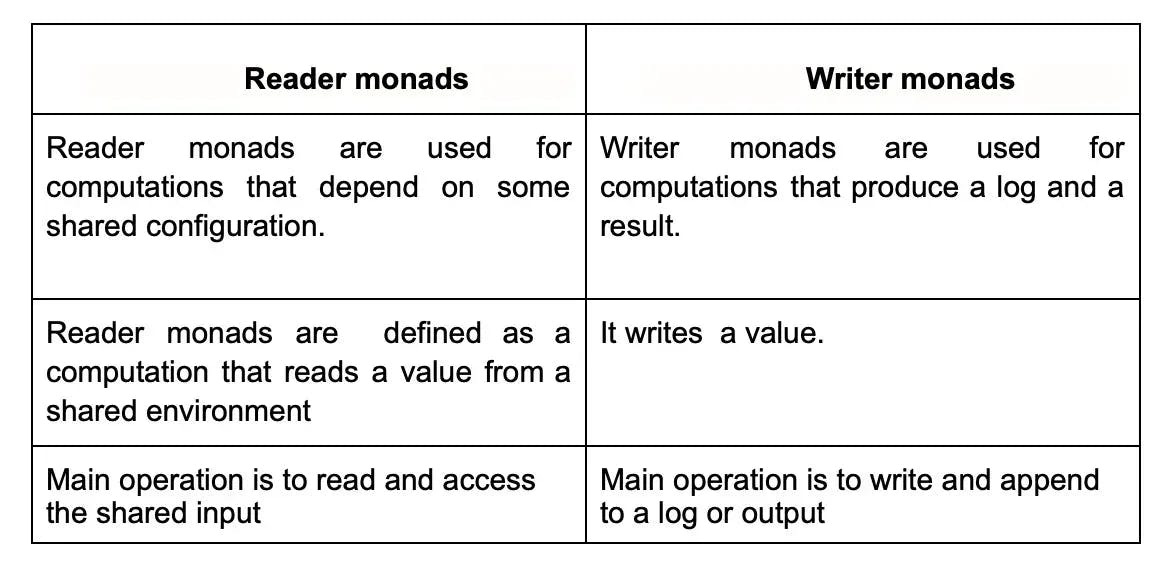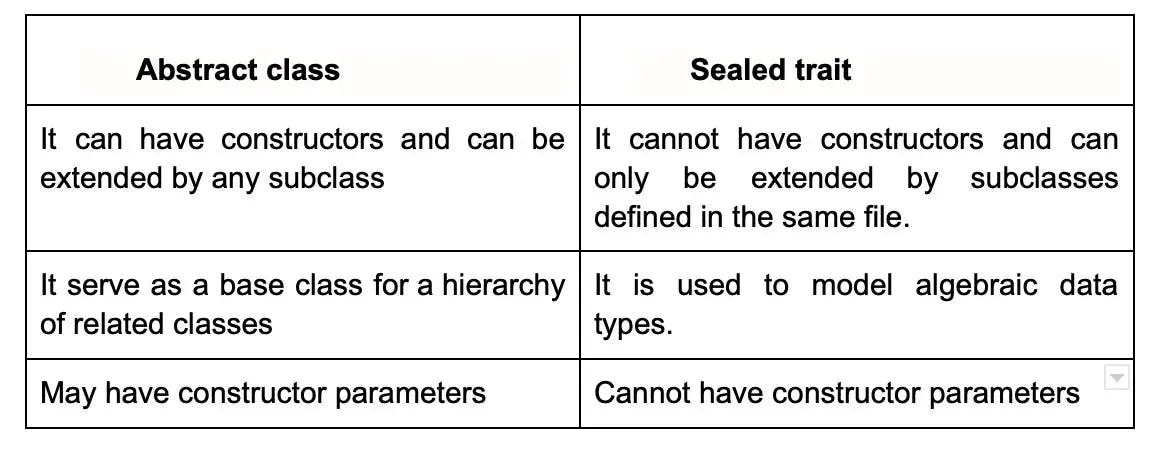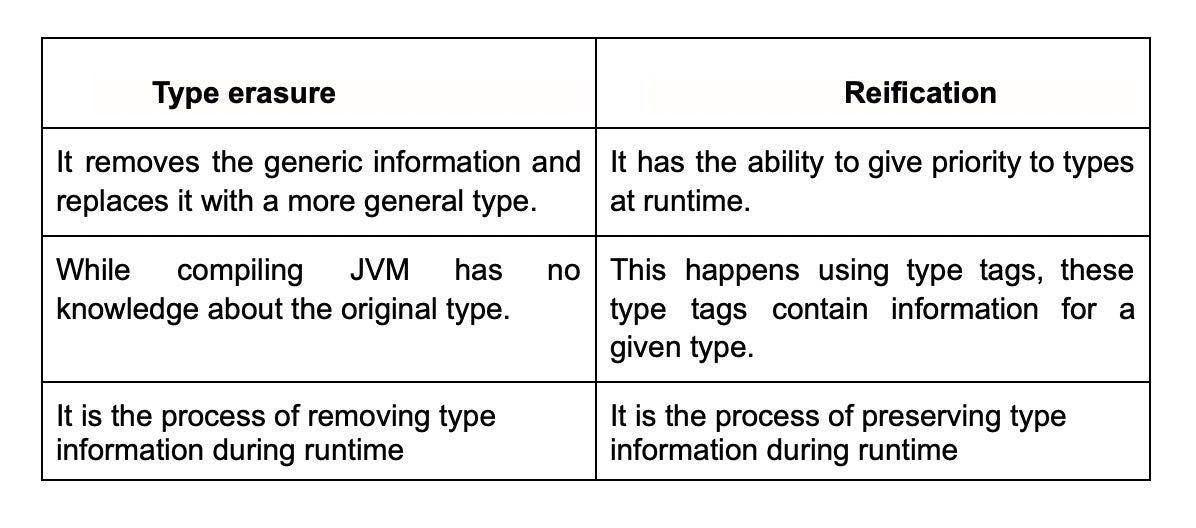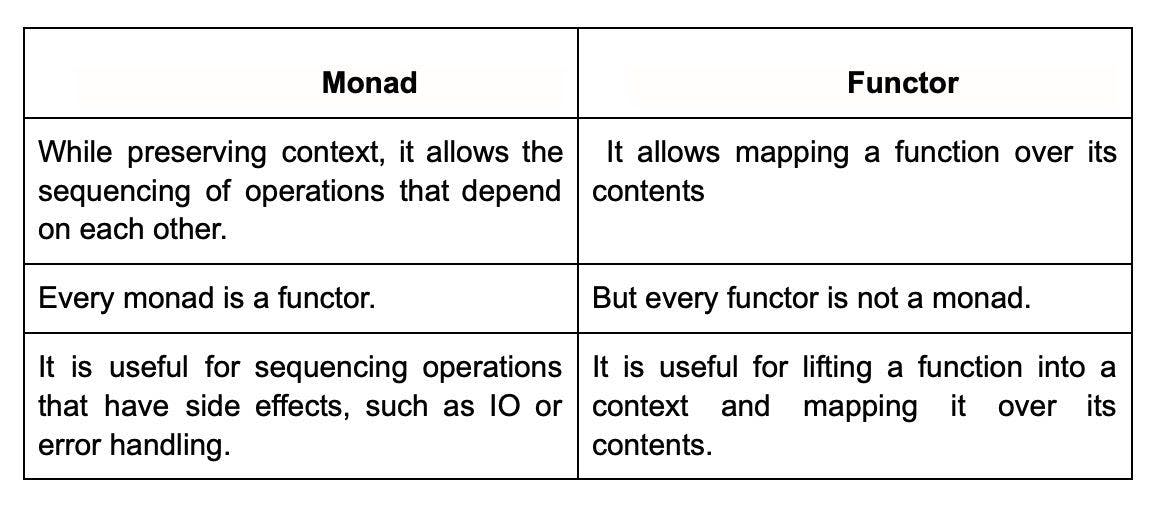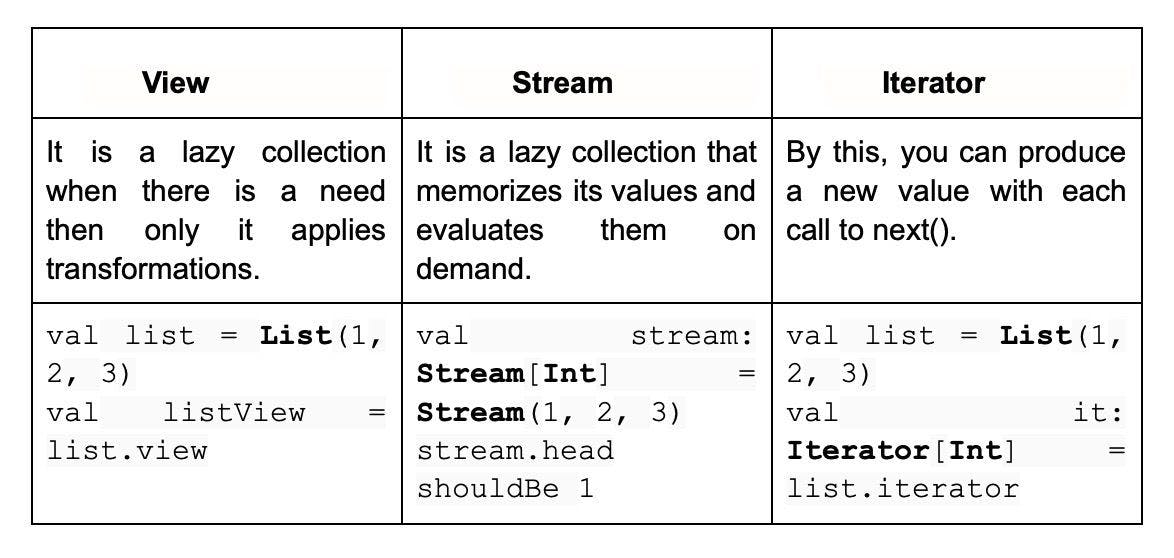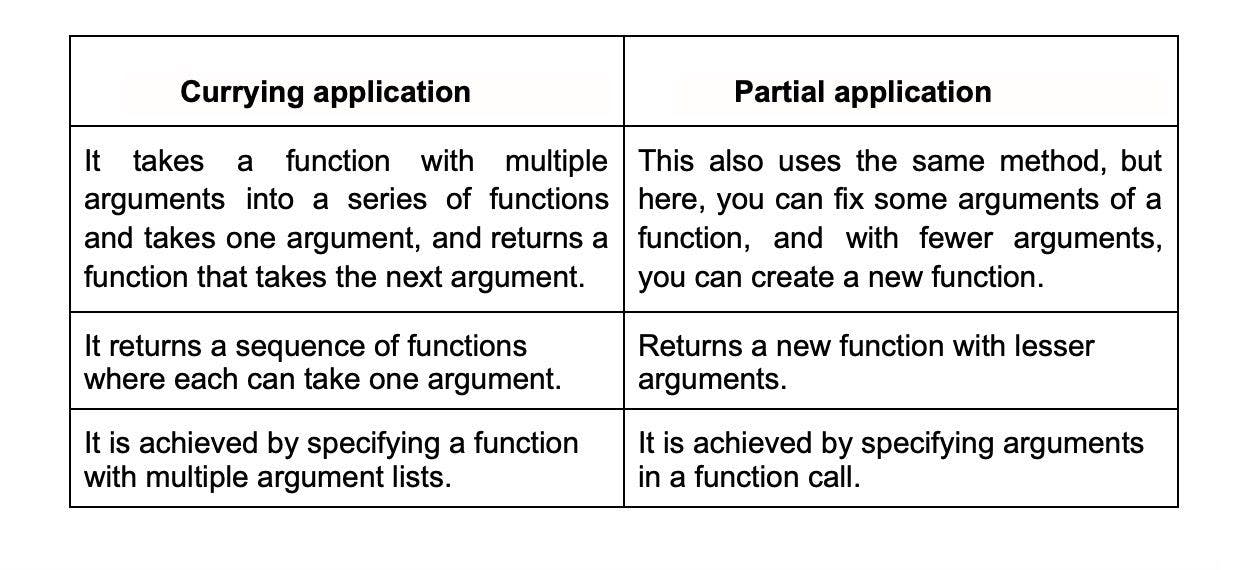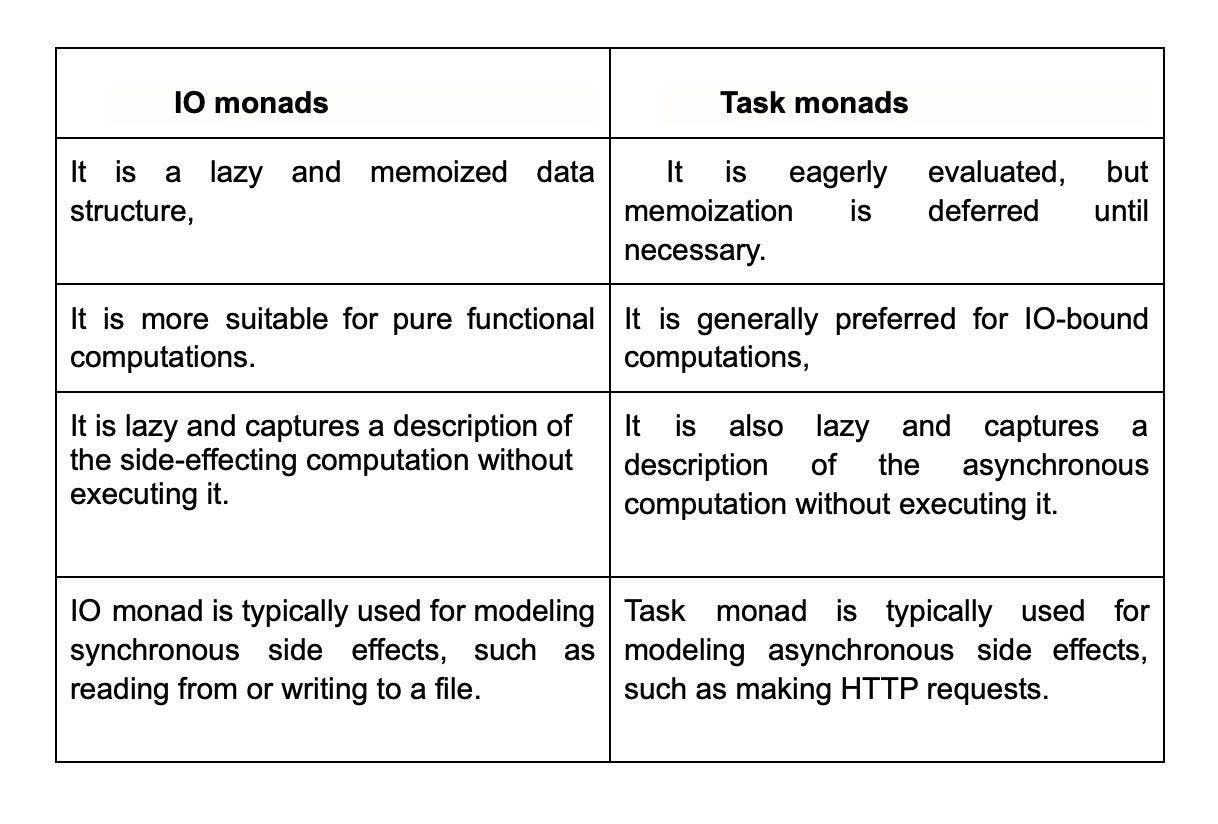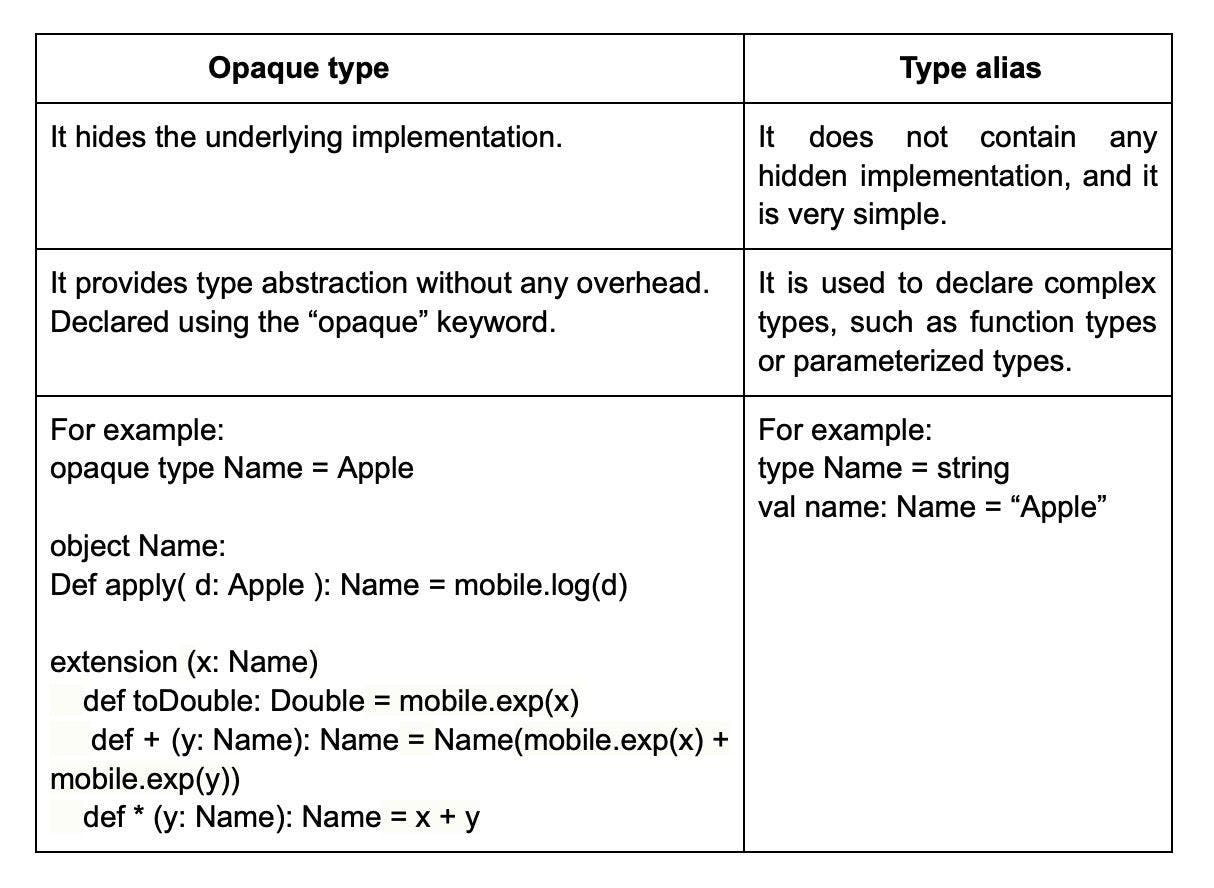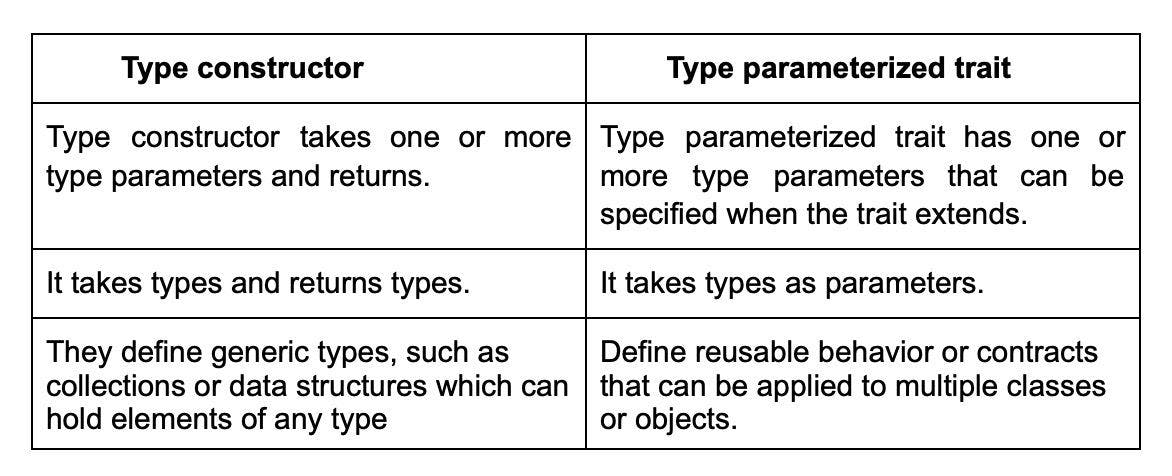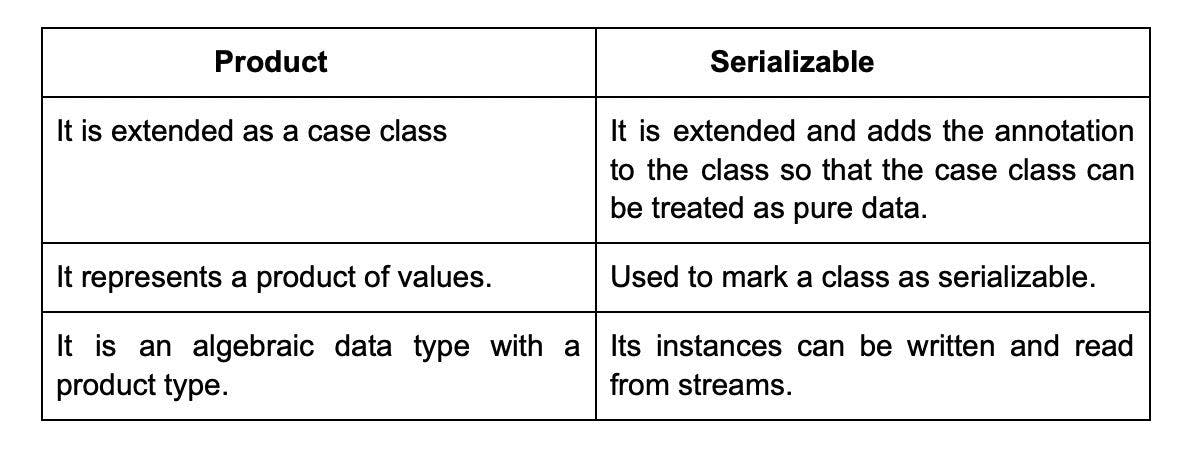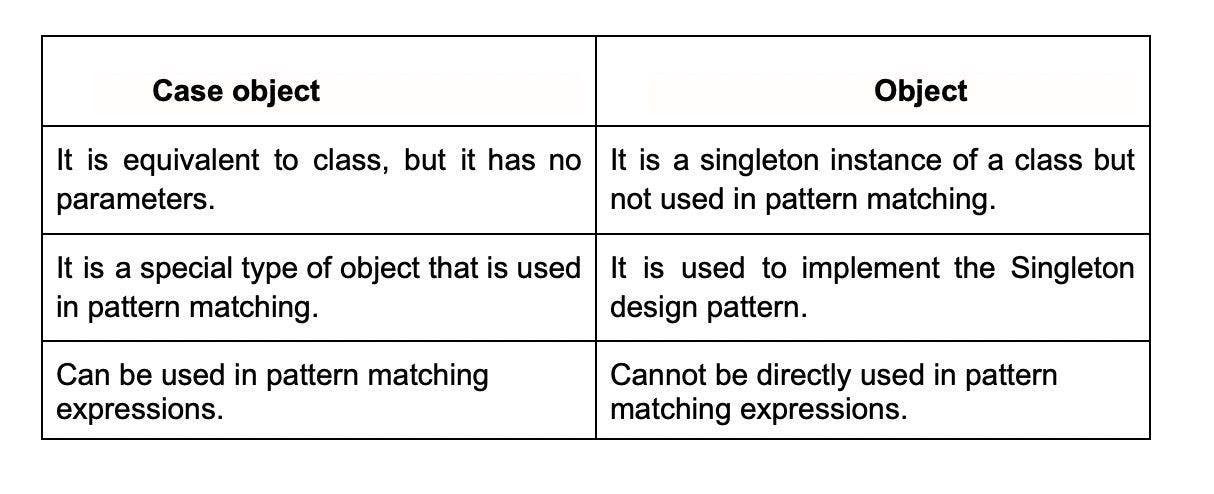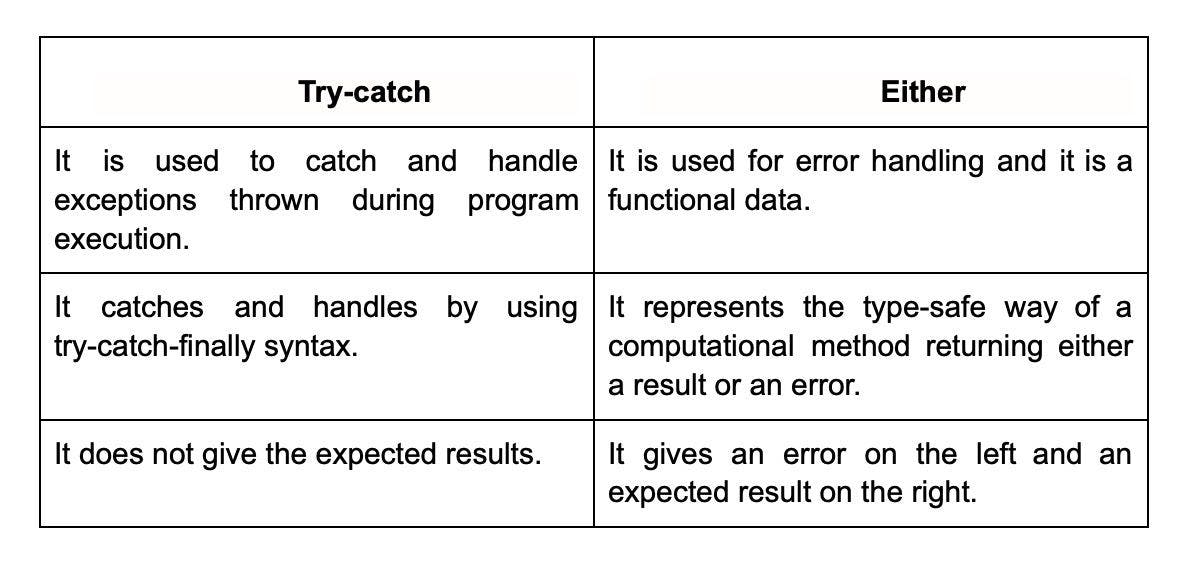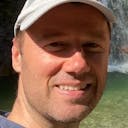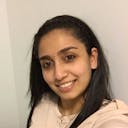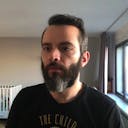
Scala
Basic Interview Q&A
1. What is Scala? What are the advantages of using Scala?
Scala is a hybrid functional programming language. Scala combined the features of object-oriented and functional languages. It was designed to express common programming patterns in a concise, elegant, and type-safe way.
Scala source code is first compiled into Java bytecode, and this executable code runs on the Java Virtual Machine (JVM). This means that Scala and Java have a high level of interoperability - Scala can use any Java class and its libraries. Scala is known for its scalability and it's used in a wide range of programming tasks, from writing small scripts to building large systems.
Scala offers several advantages that make it a popular choice among developers. Some advantages are as follows:
- Concise and expressive syntax: As Scala combines object-oriented and functional programming paradigms, it provides a clear and concise syntax. This allows developers to write code that is concise and readable.
- Strong static type system: Its static type system catches many errors at compile-time, providing reliable and bug-free code.
- Functional programming features: Scala encompasses functional programming concepts that allows developers to write modular, reusable, and composable code.
- Interoperability with Java: Scala runs on the Java Virtual Machine (JVM) and seamlessly interoperates with Java. This allows developers to reuse existing Java code and integrate with Java-based systems.
- Concurrency and parallelism: Scala has built-in support for concurrent and parallel programming.
- Scalability: With Scala's ability to scale, it can efficiently handle large-scale systems and high-performance applications.
- Tooling and ecosystem: Scala has a rich ecosystem with a wide range of libraries, frameworks, and development tools. It has robust IDE support (e.g., IntelliJ IDEA, Eclipse) and build tools like sbt.
2. What are the four types of scala identifiers?
Scala identifiers are names used to identify a variable, function, or any other user-defined item. There are four types of identifiers in Scala:
Alphanumeric Identifiers: These are similar to identifiers in other programming languages. They start with a letter or underscore, which can be followed by further letters, digits, or underscores.
Operator Identifiers: These consist of one or more operator characters. Operator characters are printable ASCII characters such as +, -, *, /, :, etc.
Mixed Identifiers: These start with an alphanumeric identifier, followed by an underscore and then an operator identifier. For example, unary_+.
Literal Identifiers: These are arbitrary strings enclosed in backticks (`).
3. Name different types of Scala literals.
Different types of Scala literals are:
- Boolean Literals
- Symbol Literals
- Integer literals
- Character literals
- String literals
- Floating-point literals
4. Explain ofDim() in Scala.
In Scala, ofDim() is a method used to create multidimensional arrays. The name "ofDim" stands for "of Dimension." This method is a part of the Array object, and it allows you to create arrays with multiple dimensions, such as 2D arrays, 3D arrays, and so on.
The syntax for using ofDim() is as follows:
def ofDim[T](dims: Int*)(implicit evidence$1: reflect.ClassTag[T]): Array[T]
Parameters:
T: The type of elements that the array will hold.
dims: A variable number of arguments that specify the size of each dimension of the array.
5. What is a Scala set? What are its different types?
In Scala, a Set is a collection of unique elements of the same type, with no particular order. It does not allow duplicate values. There are two main types of sets in Scala: Mutable and Immutable. By default, Scala uses Immutable sets.
Immutable Sets (scala.collection.immutable.Set): Once created, these sets cannot be altered. This means that operations like adding or removing elements will create a new set.
Mutable Sets (scala.collection.mutable.Set): These sets allow the addition, removal, and updating of elements in-place. However, they are not thread-safe by default and require external synchronization when accessed concurrently.
Additionally, Scala provides a HashSet (scala.collection.mutable.HashSet), which is a mutable set optimized for fast element lookup. It's important to note that a HashSet is not ordered, and the order of elements may change.
6. What are scala maps?
In Scala, a Map is a collection of key-value pairs, where each key must be unique. It's essentially a set of associations that map keys to values. Maps are useful when we want to retrieve a value by looking up a particular key.
Scala provides two types of Maps:
Immutable Maps (scala.collection.immutable.Map): These are the default Map types in Scala. Once an Immutable Map is created, it cannot be changed. This means that operations like adding, updating, or removing key-value pairs will create a new Map.
Example: val map = Map("a" -> 1, "b" -> 2)
Mutable Maps (scala.collection.mutable.Map): These Maps allow the addition, removal, and updating of key-value pairs in-place.
Example: val map = scala.collection.mutable.Map("a" -> 1, "b" -> 2)
In both examples, "a" and "b" are keys, and 1 and 2 are their corresponding values.
7. What are scala variables?
In Scala, variables are named storage locations that our programs can manipulate. Each variable in Scala has a specific type, which determines the size and layout of the variable's memory, the range of values that can be stored within that memory, and the set of operations that can be applied to the variable.
Scala has two types of variables:
Mutable variables: These are declared using the var keyword and can be reassigned after their initial declaration.
Example: var x = 10
Immutable variables: These are declared using the val keyword and cannot be reassigned once initialized. They are essentially read-only and similar to final variables in Java.
Example: val y = 20
In both examples, x and y are variables, 10 and 20 are their respective values.
8. What is the difference between class and object?

9. What is a tail recursion in Scala?
Tail recursion is a technique used in functional programming where a function calls itself recursively as its last action. In other words, the recursive call is the final operation executed in the function. This approach is important for writing efficient and stack-safe recursive algorithms.
In traditional recursion, each recursive call adds a new frame to the call stack, potentially leading to a stack overflow error for deep recursion. Tail recursion, on the other hand, reuses the current function's stack frame for the next recursive call, eliminating the risk of a stack overflow.
Key Features of Tail Recursion:
Last Operation: In a tail-recursive function, the recursive call is the last operation performed in the function before returning a result.
Stack Efficiency: Tail recursion optimizes memory usage by reusing the same stack frame for each recursive call, preventing stack overflow issues.
Functional Style: Tail recursion aligns well with the functional programming paradigm, promoting a clearer and more concise coding style.
10. What is the Scala trait?
In Scala, a trait is a fundamental building block that defines a reusable interface with methods and field definitions. Traits are similar to Java interfaces but provide more flexibility by allowing both abstract and concrete methods. You have the freedom to create traits with entirely abstract methods or a mix of abstract and implemented methods.
Key Characteristics of Scala Traits:
Method and Field Definitions: A trait can include method signatures (abstract methods) and field definitions (variables).
Abstract and Concrete Methods: Traits can contain methods that must be implemented by classes that use the trait, as well as methods with default implementations.
Mixin Composition: Classes can extend multiple traits, enabling flexible code reuse through mixin composition.
Instantiation: Traits cannot be instantiated directly; they serve as blueprints for classes.
11. What are case classes?
Case classes are a special type of class in Scala designed primarily for modeling immutable data structures. They come with built-in features that make them convenient for working with immutable data, enabling pattern matching and automatic generation of common methods.
Some key features of case classes are as follows:
Immutable by Default: Case classes are automatically immutable, ensuring that their properties (fields) cannot be changed after creation. This promotes safer and more reliable code by preventing unintended modifications.
Automatic Getter Methods: Case classes automatically generate getter methods for their fields. This makes it straightforward to access the values stored in instances of case classes.
Structural Equality: Case classes provide built-in implementations of the equals and hashCode methods based on the values of their fields. This enables reliable and consistent comparison of case class instances for equality.
Pattern Matching: One of the most powerful features of case classes is their seamless integration with pattern matching. They are commonly used in pattern matching expressions to destructure case class instances, extract their values, and take different actions based on the matched patterns.
12. How can you format a string?
In a program, you can use the .format() method to format a string.
For an example: var p = m.format(q, g)
In Scala, a string can be formatted using the format method. With the format method you can insert values into a string by specifying placeholders and providing corresponding values.
Here's an example

13. Why does Scala prefer immutability?
In Scala, immutable objects are first-class citizens, and their preference is by default. They help to cope with equality issues and concurrent programs like they prohibit mistakes in distributed systems and give you thread-safe data.
14. How can we append to the list?
Using the keyword 'append()', you can add a list within a list. If you want to add a new object to another list that is already prepared, you can add it by using the append() keyword. For example,
var myList = List.empty[String]
myList :+= "p"
myList :+= "q"
myList :+= "r"
use++ for appending a list
var myList = List.empty[String]
myList ++= List("p", "q", "r")
15. What is the basic difference between var and value?
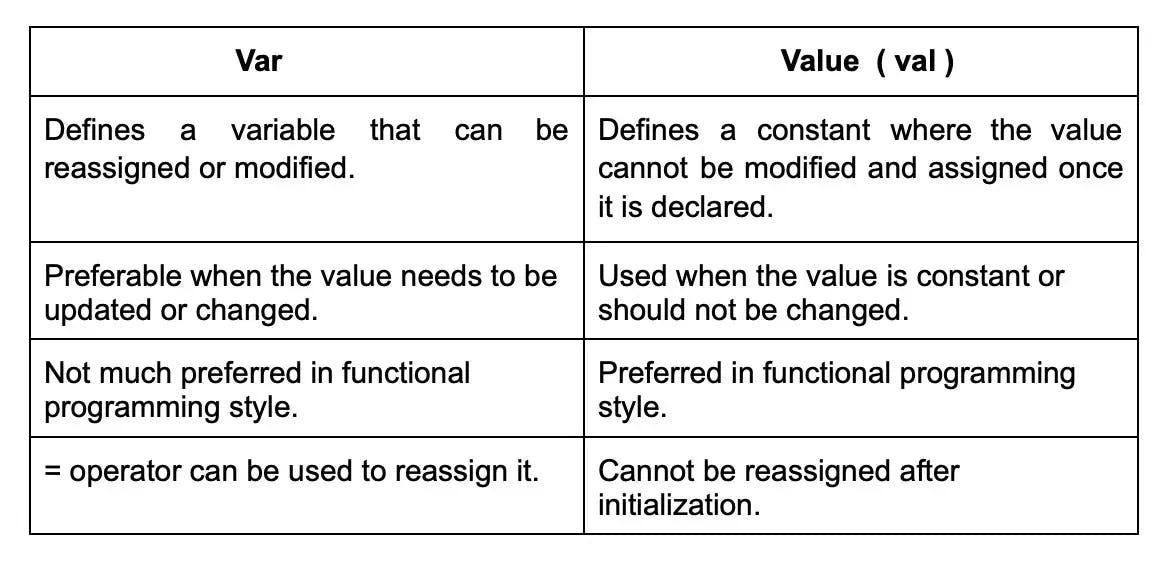
16. Compare Scala with other programming languages.
- Scala code is easily readable and error-free and doesn't contain unnecessary information.
- It is more uncomplicated than other programming languages and easy to write, compile, and run the code.
- In Scala, concurrency helps in parallelizing tasks.
- In Scala, problems will be solved from many different angles with the help of functional programming.
Now let's compare it against two popular programming languages Python and Java.
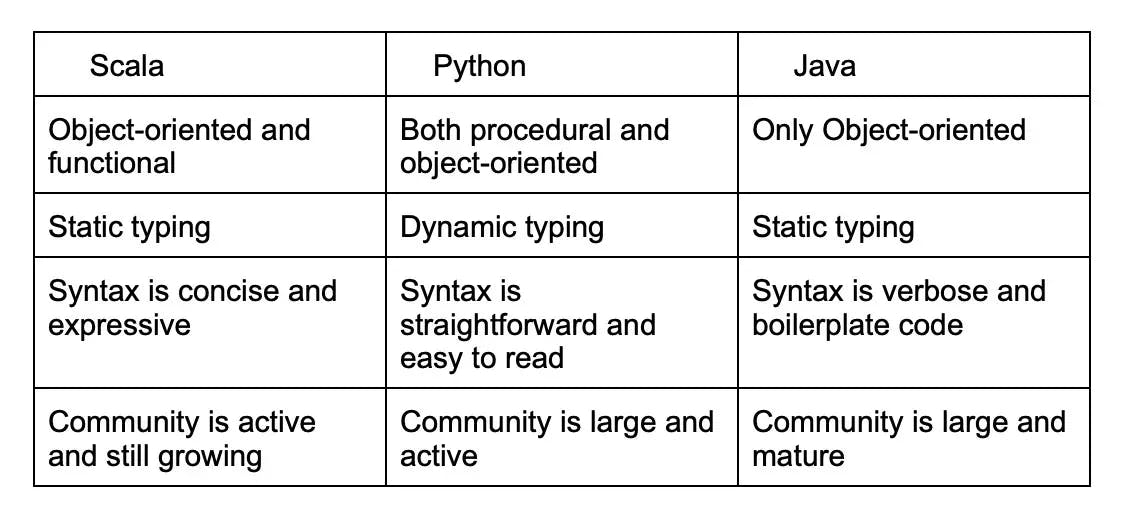
17. What is the use of tuples in Scala?.
Tuples in Scala are a collection of immutable elements. They can hold a fixed number of elements, each with its type. They are useful when you need to group multiple values and treat them as a single entity. Here are some common use cases for tuples:
- To return multiple values
- To group related data
- For iterating over collections
- Pattern matching
Also, you must remember that tuples in Scala are indexed starting from 1, unlike arrays or lists that are indexed starting from 0.
18. What is the use of function currying in Scala?
It is a method of converting a function with several arguments into a sequence of functions that take one argument. It has all kinds of parameter lists and is globally used in a vast range of functional languages.
19. What are the implicit parameters in Scala?
With Scala's implicit parameters , you can define the parameters that are automatically filled in by the compiler depending on their type. When a method or function has implicit parameters, you can skip providing those parameters explicitly when calling the method. Instead, the compiler will find out suitable values in the current scope and automatically pass them.

20. What are closures in Scala?
It is a method which uses multiple free variables and whose return value depends on the value of those free variables which are declared outside this method. Outside variables are not bound to a function with a valid value.
21. What are Scala's higher-order functions?
In Scala higher-order functions contain other functions as input and give output by returning a function.
In Scala, higher-order functions are those functions that can take other functions as parameters or return functions as output. They allow functions to be manipulated and passed around like any other value.
Scala's support for higher-order functions is one of powerful feature that allows functional programming techniques. Here are some examples of higher-order functions in Scala:
Map: The map function applies a given function to every element of a collection and returns a new collection with the changed values.
Filter: The filter function takes a predicate function and returns only the elements that obey the predicate.
Reduce: Applies a binary operation to the elements of a collection and returns a single value.
FlatMap: Applies a function to each element of a collection and flattens the results into a single collection.
22. Explain about Scala anonymous function.
Anonymous functions are those functions that are not defined by name and are useful when you want to create an inline function. You can define several arguments in an anonymous function.
23. List name of a few frameworks that Scala supports.
- Akka Framework
- Neo4j Framework
- Lift Framework
- Spark Framework
- Play Framework
- Scalding Framework
- Bowler Framework
24. Mention the types of variables in Scala.
There are two types of variable mutable and immutable variables:

25. What is a stream in Scala?
In Scala, the stream is an inactive or lazy list where elements are accessed only when they are required. It is faster processing because the elements in the list are only evacuated when they are really needed. However, it is important to note that streams are not necessarily faster in processing; their advantage lies in their lazy evaluation behavior.
26. Give the names of Operators in Scala.
In Scala, the following are the names of the commonly used operators:
- Arithmetic Operators
- Relational Operators
- Logical Operators
- Bitwise Operators
- Assignment Operators
27. Why do we need an App in Scala?
The app is a helper class that is provided by Scala, which provides the main method. You don't have to write the main method every time instead , the App class produces concise and executable applications in Scala.
28. Write the types of scope provided for variables in Scala.
In Scala, three types of scopes for variables are provided:
Fields: Field variables are declared within a class or object and represent the state or properties of that class or object. They can be accessed and modified from anywhere within the scope of the class or object, depending on their access modifiers (private, protected, or public). Fields can be declared using both var (mutable) and val (immutable).
Method Parameters: Method parameters are variables that are passed to a method when it is called. They are accessible only within the body of the method and are used to process the values passed to the method. Method parameters are immutable by default, meaning their values cannot be changed within the method.
Local Variables: Local variables are declared within a method or a block and are accessible only within that method or block. They are used to store temporary values or intermediate results. Local variables are typically declared using the val keyword, making them immutable.
29. Mention how Scala is different from Java?

30. Explain how Scala is similar to object-oriented and functional programming languages?
Scala is a language that combines both object-oriented and functional programming . It takes concepts and features from both which makes it a versatile language. Here's an explanation of how Scala is similar to object-oriented and functional programming languages:
With Object-Oriented Programming (OOP):
- Objects and Classes: Scala is an object-oriented language, and allows the creation of objects and classes.
- Encapsulation: Scala allows to encapsulate data and behavior within classes.
- Inheritance and Polymorphism: Scala supports inheritance and allows classes to extend other classes. It also supports polymorphism.
- Message Passing: Scala treats objects as different entities that communicate with each other by exchange of messages.
With Functional Programming (FP):
- Immutable Data: Immutable data structures are used by default.
- Higher-Order Functions: In Scala functions are treated as first-class citizens, where you can pass functions as arguments, return functions as results, and assign functions to variables.
- Function Composition: With function composition you can combine multiple functions to create new functions.
- Pattern Matching: Scala allows Pattern matching, a powerful feature of functional programming.
- Immutability by Default: Scala supports immutable variables and data structures, which coincide with functional programming principles.
Wrapping up
To conclude, preparing for a Scala interview is the first step towards securing a Scala developer position. The interview questions mostly entail testing your knowledge of Scala's core concepts, syntax, functional programming, object-oriented programming, and other related topics. Also, practice the coding examples given above, check what Scala libraries are there, its frameworks and also remain updated with new trends in Scala development.
Also, you can apply to Turing if you are looking for a Scala job in elite US companies. All you will need to do is take the Turing test. Conversely, if you are a recruiter, and want to skip this process and have hours of your hiring time, you can opt for Turing too which helps you source, vet, match, and manage the world's best Scala developers remotely.
Hire Silicon Valley-caliber Scala developers at half the cost
Turing helps companies match with top quality remote JavaScript developers from across the world in a matter of days. Scale your engineering team with pre-vetted JavaScript developers at the push of a buttton.
Tired of interviewing candidates to find the best developers?
Hire top vetted developers within 4 days.
Leading enterprises, startups, and more have trusted Turing

Check out more interview questions
Hire remote developers
Tell us the skills you need and we'll find the best developer for you in days, not weeks.


